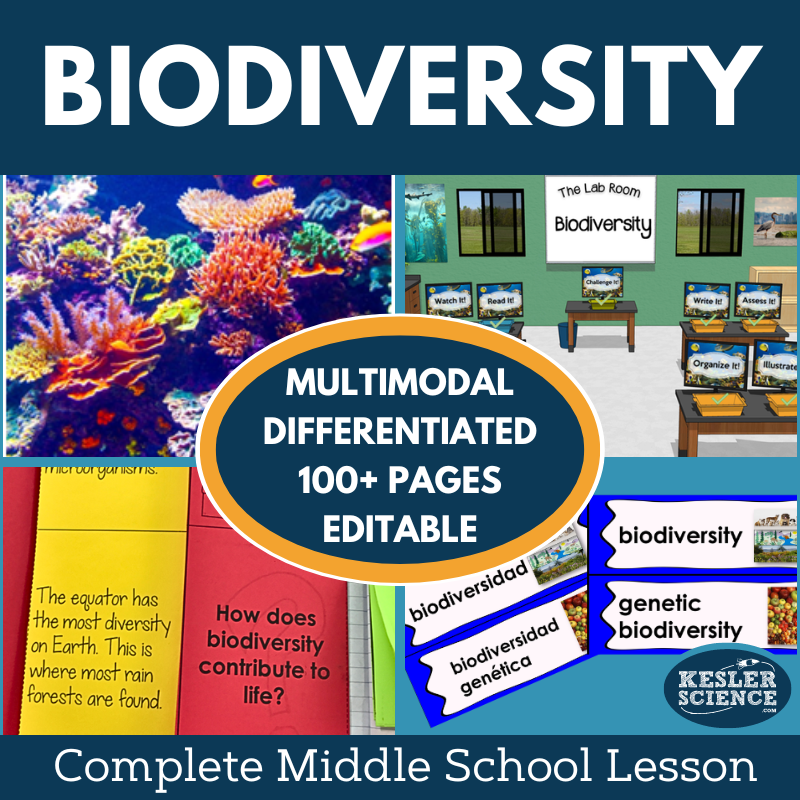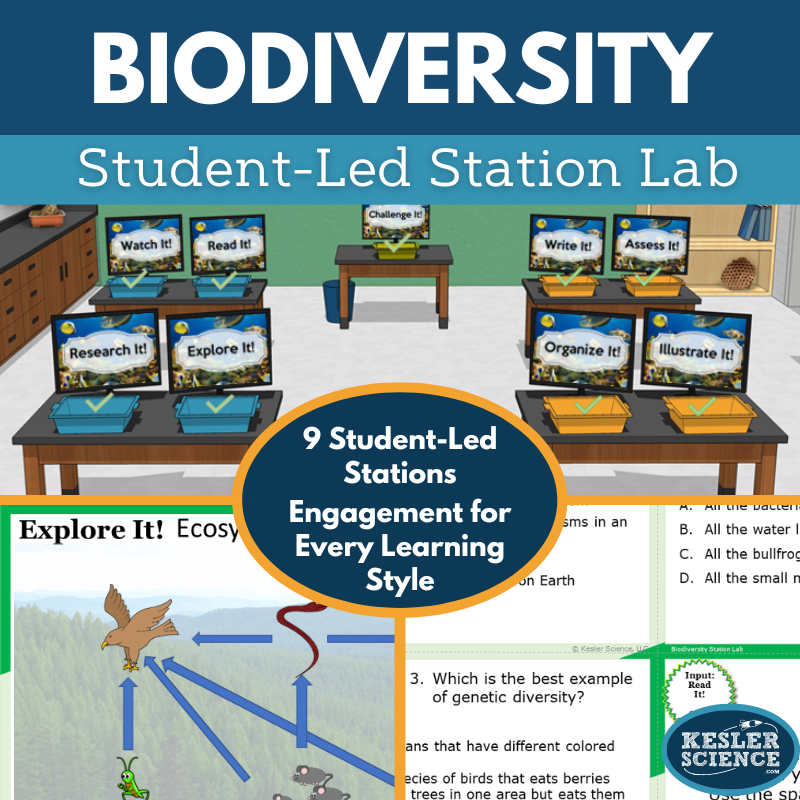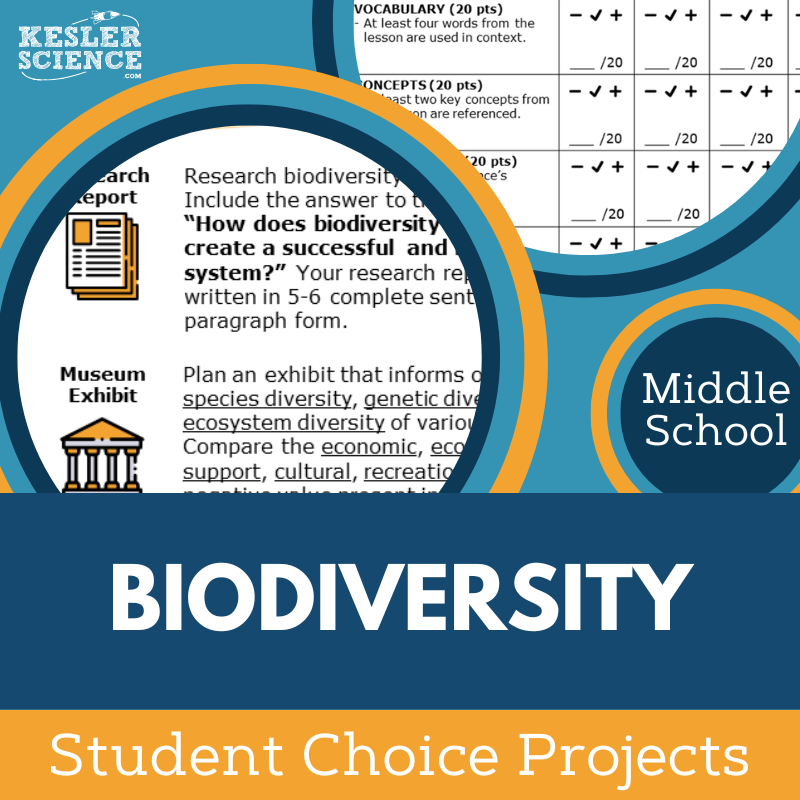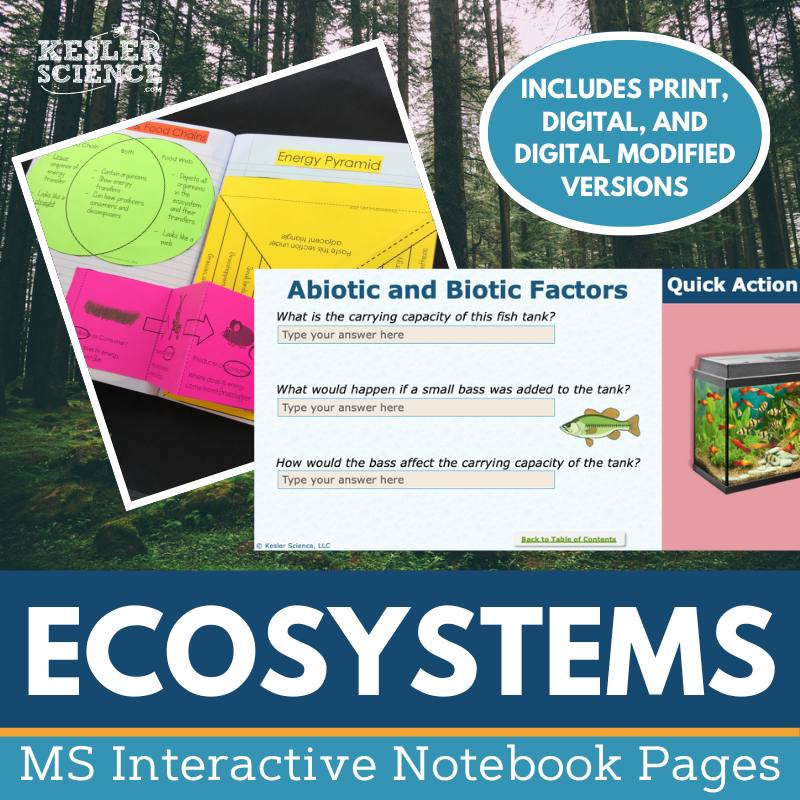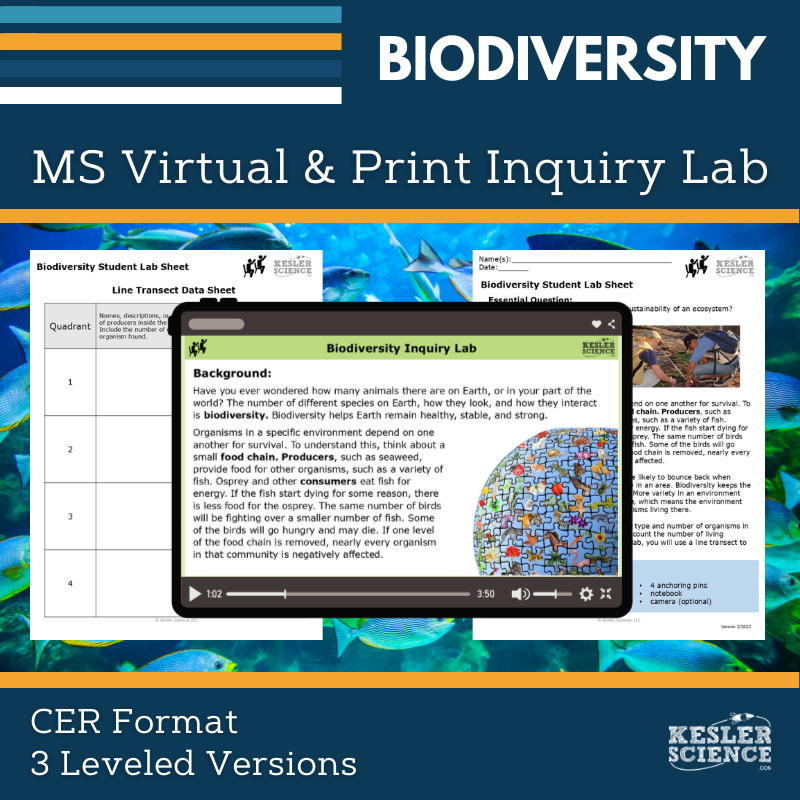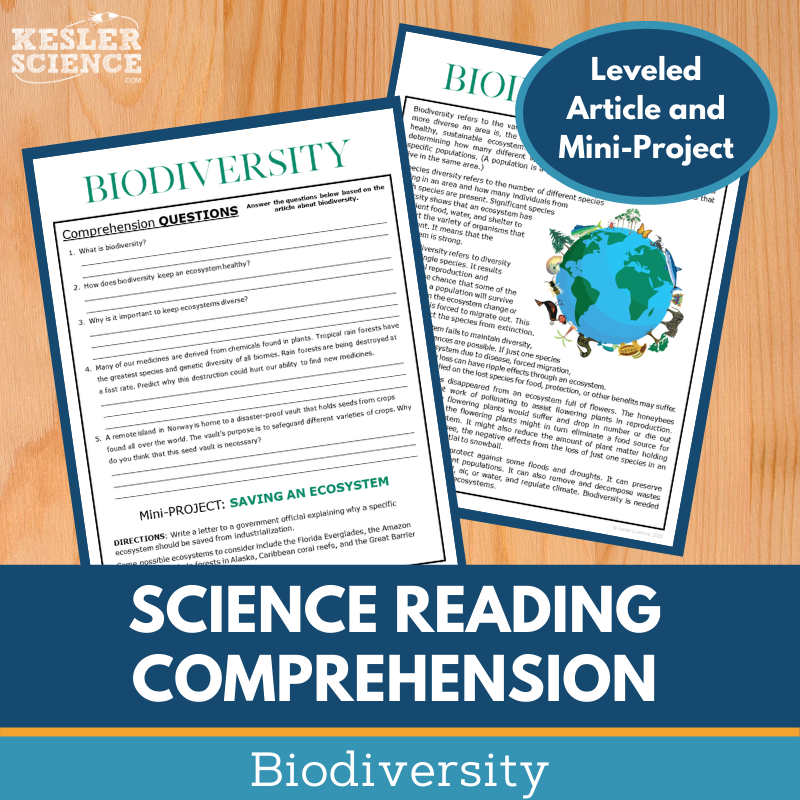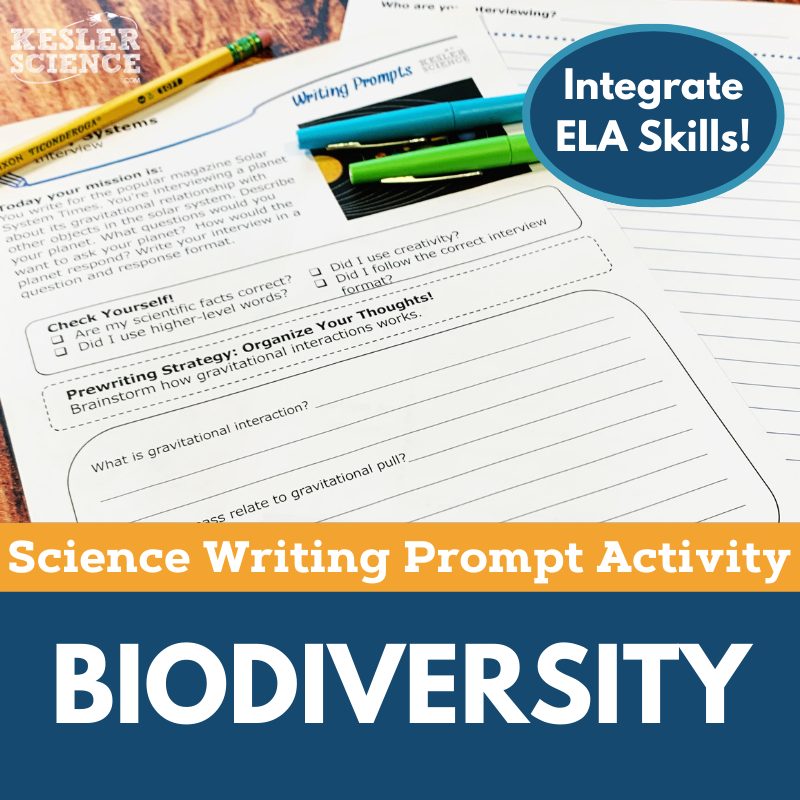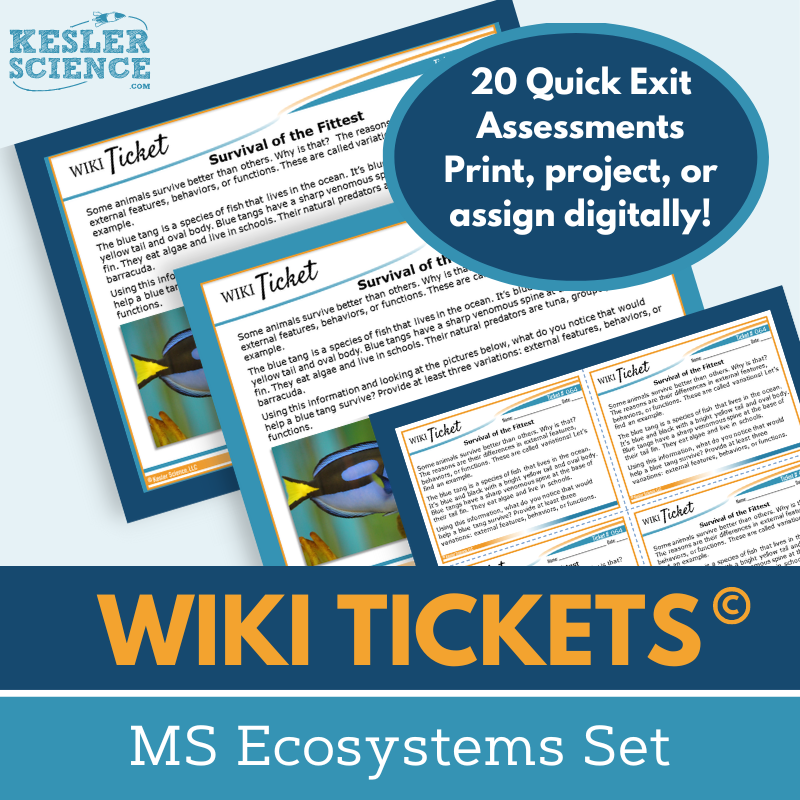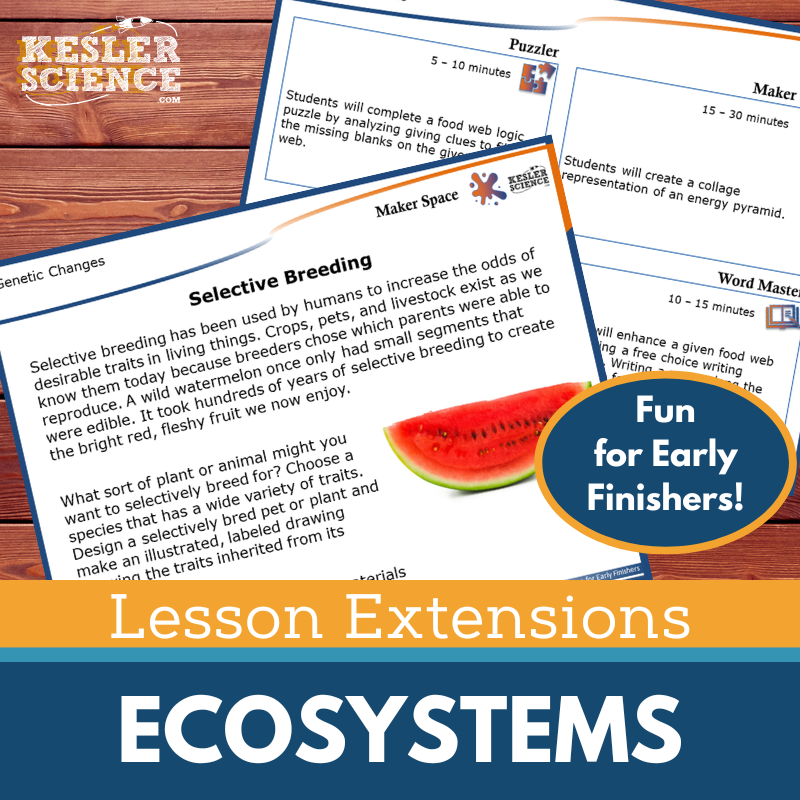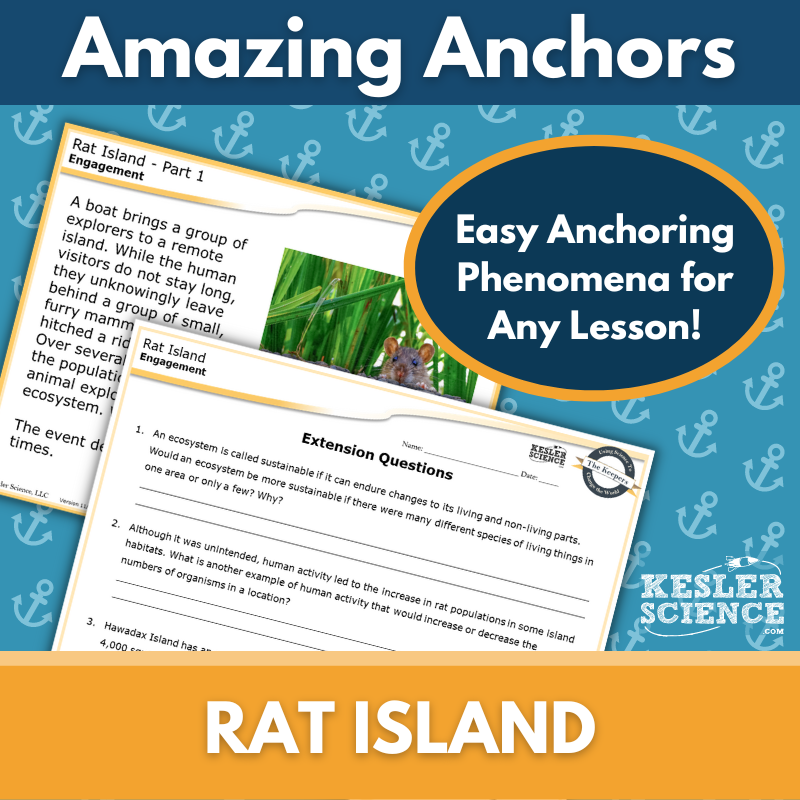Biodiversity Activities for Middle School Science
The Kesler Science Biodiversity resources provide middle school students with engaging, student-centered activities that explore the importance of biodiversity in sustaining ecosystems. The resources below will give students a comprehensive understanding of biodiversity. All of the following materials are also included in the Kesler Science Membership.
The Kesler Science Biodiversity Complete 5E Lesson is a multi-day, student-centered resource designed to help middle school students explore how biodiversity contributes to ecosystem sustainability. Using the 5E Model—Engagement, Exploration, Explanation, Elaboration, and Evaluation—this lesson ensures a well-rounded and engaging learning experience. With minimal prep, differentiated materials, and flexible formats, teachers can tailor the lesson to their students’ needs while fostering curiosity and success.
The lesson includes multimodal activities like a student-led station lab with nine differentiated stations, editable PowerPoints, and interactive notebook templates in English and Spanish. Students can explore biodiversity through hands-on tasks, readings, research, and videos, then demonstrate their understanding with creative outputs like card sorts, writing prompts, and visual projects. A bonus "Challenge It!" station extends learning for advanced students, while student-choice projects offer further opportunities for independent exploration.
With printable and digital options, this resource adapts seamlessly to in-person or virtual learning environments. Standards-aligned assessments, editable templates, and vocabulary in both English and Spanish ensure accessibility for diverse learners, making this 5E lesson a comprehensive and flexible addition to any classroom.
The Kesler Science Biodiversity Complete 5E Lesson is a multi-day, student-centered resource designed to help middle school students explore how biodiversity contributes to ecosystem sustainability. Using the 5E Model—Engagement, Exploration, Explanation, Elaboration, and Evaluation—this lesson ensures a well-rounded and engaging learning experience. With minimal prep, differentiated materials, and flexible formats, teachers can tailor the lesson to their students’ needs while fostering curiosity and success.
The lesson includes multimodal activities like a student-led station lab with nine differentiated stations, editable PowerPoints, and interactive notebook templates in English and Spanish. Students can explore biodiversity through hands-on tasks, readings, research, and videos, then demonstrate their understanding with creative outputs like card sorts, writing prompts, and visual projects. A bonus "Challenge It!" station extends learning for advanced students, while student-choice projects offer further opportunities for independent exploration.
With printable and digital options, this resource adapts seamlessly to in-person or virtual learning environments. Standards-aligned assessments, editable templates, and vocabulary in both English and Spanish ensure accessibility for diverse learners, making this 5E lesson a comprehensive and flexible addition to any classroom.
The Kesler Science Biodiversity Station Lab is a student-led activity that empowers middle school students to explore biodiversity through hands-on and interactive learning. With eight differentiated stations and a bonus challenge station for early finishers, this lab fosters a student-centered experience where the teacher serves as a facilitator.
Students will investigate biodiversity through multimodal stations like "Explore It!", "Research It!", "Read It!", and "Watch It!", allowing them to encounter new concepts in varied ways. They will demonstrate their understanding through creative output stations, including "Organize It!", "Illustrate It!", and "Write It!", while the “Assess It!” station reinforces comprehension. The “Challenge It!” station offers advanced tasks to extend learning for early finishers.
This modular lab includes all necessary materials, task cards, and signage for seamless setup, along with differentiated resources in English and Spanish. Designed for flexibility, the lab works perfectly in both traditional and virtual classrooms, with digital options that allow students to manipulate images and text in PowerPoint or Google Slides.
The Kesler Science Biodiversity Station Lab is a student-led activity that empowers middle school students to explore biodiversity through hands-on and interactive learning. With eight differentiated stations and a bonus challenge station for early finishers, this lab fosters a student-centered experience where the teacher serves as a facilitator.
Students will investigate biodiversity through multimodal stations like "Explore It!", "Research It!", "Read It!", and "Watch It!", allowing them to encounter new concepts in varied ways. They will demonstrate their understanding through creative output stations, including "Organize It!", "Illustrate It!", and "Write It!", while the “Assess It!” station reinforces comprehension. The “Challenge It!” station offers advanced tasks to extend learning for early finishers.
This modular lab includes all necessary materials, task cards, and signage for seamless setup, along with differentiated resources in English and Spanish. Designed for flexibility, the lab works perfectly in both traditional and virtual classrooms, with digital options that allow students to manipulate images and text in PowerPoint or Google Slides.
The Kesler Science Biodiversity Student Choice Projects allow middle school students to demonstrate their understanding of biodiversity through a variety of creative options. With six project choices and a “design your own” option, students can select a project that best fits their learning style. A grading rubric ensures clear assessment by teachers, peers, or students themselves.
This resource includes nine choice board options, teacher directions for support, and editable rubric pages that assess vocabulary, concepts, presentation, clarity, and accuracy. Differentiation is built in, with a modified project page offering targeted options for students needing additional support and challenges available for advanced learners.
The projects require minimal supplies, relying on typical classroom materials like paper, markers, and scissors, with digital completion options for flexibility. Whether through hands-on models or digital presentations, this lesson provides a dynamic, student-centered approach to exploring biodiversity.
The Kesler Science Biodiversity Student Choice Projects allow middle school students to demonstrate their understanding of biodiversity through a variety of creative options. With six project choices and a “design your own” option, students can select a project that best fits their learning style. A grading rubric ensures clear assessment by teachers, peers, or students themselves.
This resource includes nine choice board options, teacher directions for support, and editable rubric pages that assess vocabulary, concepts, presentation, clarity, and accuracy. Differentiation is built in, with a modified project page offering targeted options for students needing additional support and challenges available for advanced learners.
The projects require minimal supplies, relying on typical classroom materials like paper, markers, and scissors, with digital completion options for flexibility. Whether through hands-on models or digital presentations, this lesson provides a dynamic, student-centered approach to exploring biodiversity.
The Kesler Science Ecosystems Interactive Notebook Bundle provides an engaging and interactive way for students to explore key ecosystems concepts. Designed for flexibility, the resource includes both print and digital versions, making it suitable for traditional classrooms, 1:1 environments, and distance learning settings.
The bundle covers a wide range of topics, including biotic and abiotic factors, biomes, food webs, symbiosis, and the nitrogen and carbon cycles. Digital features include a unique interactive notebook PowerPoint, editable Google Slides compatibility, reflection pages, and modified versions for students with accommodations. The paper version includes blank and pre-filled templates, complete with color examples to guide students and teachers.
This resource supports differentiated instruction and accommodates all learners with thoughtfully designed templates and modifications. Whether in person or online, the Ecosystems Interactive Notebook promotes active learning, critical thinking, and scientific literacy.
The Kesler Science Ecosystems Interactive Notebook Bundle provides an engaging and interactive way for students to explore key ecosystems concepts. Designed for flexibility, the resource includes both print and digital versions, making it suitable for traditional classrooms, 1:1 environments, and distance learning settings.
The bundle covers a wide range of topics, including biotic and abiotic factors, biomes, food webs, symbiosis, and the nitrogen and carbon cycles. Digital features include a unique interactive notebook PowerPoint, editable Google Slides compatibility, reflection pages, and modified versions for students with accommodations. The paper version includes blank and pre-filled templates, complete with color examples to guide students and teachers.
This resource supports differentiated instruction and accommodates all learners with thoughtfully designed templates and modifications. Whether in person or online, the Ecosystems Interactive Notebook promotes active learning, critical thinking, and scientific literacy.
The Biodiversity Inquiry Lab aligns with NGSS standards and engages students in analyzing the biodiversity of their school environment using a line transect method. Students will identify and count different types of organisms present and explore how biodiversity contributes to ecosystem sustainability. Both print and digital formats include comprehension questions, Claim-Evidence-Reasoning (C.E.R.) prompts, and a reflection section to support deeper learning.
This lab includes three differentiated versions—dependent, modified, and independent—to accommodate diverse learners. The dependent version offers guided procedures and inquiry, the modified version provides extra support and structure, and the independent version encourages student-led exploration. Teachers can choose the format and level that best fits their students’ needs.
Printable and digital versions are included, with editable files compatible with Google Slides and PowerPoint. The digital format features a pre-recorded video demonstration for students without access to materials. Teacher resources include answer keys, prep directions, and editable content for maximum flexibility in the classroom.
The Biodiversity Inquiry Lab aligns with NGSS standards and engages students in analyzing the biodiversity of their school environment using a line transect method. Students will identify and count different types of organisms present and explore how biodiversity contributes to ecosystem sustainability. Both print and digital formats include comprehension questions, Claim-Evidence-Reasoning (C.E.R.) prompts, and a reflection section to support deeper learning.
This lab includes three differentiated versions—dependent, modified, and independent—to accommodate diverse learners. The dependent version offers guided procedures and inquiry, the modified version provides extra support and structure, and the independent version encourages student-led exploration. Teachers can choose the format and level that best fits their students’ needs.
Printable and digital versions are included, with editable files compatible with Google Slides and PowerPoint. The digital format features a pre-recorded video demonstration for students without access to materials. Teacher resources include answer keys, prep directions, and editable content for maximum flexibility in the classroom.
The Kesler Science Biodiversity Reading Comprehension engages middle school students with an informative article about how biodiversity supports ecosystem sustainability. Students explore the topic through leveled reading passages, answer comprehension questions, and complete a persuasive writing activity to advocate for ecosystem preservation. The resource builds science literacy while fostering critical thinking and communication skills.
The lesson includes two Lexile-leveled articles (1100-1300), colorful visuals, and a hands-on mini-project, making it suitable for diverse learners in grades 6-8. With features like Cornell notes templates and differentiated questions, teachers can tailor the activities for whole-class instruction, extra credit, or independent assignments. These materials also support virtual and distance learning with editable files for Google Slides and LMS platforms.
This resource is ideal for absent students, sub plans, or enhancing reading comprehension during a biodiversity unit. The engaging content and interactive format provide opportunities for classroom discussions while promoting textual analysis and science literacy in a variety of learning environments.
The Kesler Science Biodiversity Reading Comprehension engages middle school students with an informative article about how biodiversity supports ecosystem sustainability. Students explore the topic through leveled reading passages, answer comprehension questions, and complete a persuasive writing activity to advocate for ecosystem preservation. The resource builds science literacy while fostering critical thinking and communication skills.
The lesson includes two Lexile-leveled articles (1100-1300), colorful visuals, and a hands-on mini-project, making it suitable for diverse learners in grades 6-8. With features like Cornell notes templates and differentiated questions, teachers can tailor the activities for whole-class instruction, extra credit, or independent assignments. These materials also support virtual and distance learning with editable files for Google Slides and LMS platforms.
This resource is ideal for absent students, sub plans, or enhancing reading comprehension during a biodiversity unit. The engaging content and interactive format provide opportunities for classroom discussions while promoting textual analysis and science literacy in a variety of learning environments.
The Kesler Science Biodiversity Writing Prompt Activity engages middle school students with a creative call-to-action letter format that enhances their understanding of biodiversity. This activity encourages critical thinking and science reasoning while allowing students to enrich their writing skills. Designed for both in-person and virtual learning, the low-prep materials include full and half-sheet handouts, rubrics, and a digital interactive version to suit diverse classroom needs.
The writing prompt includes pre-writing strategies, self-checks, and templates, making it perfect for elaboration activities, review, or cross-curricular connections. It aligns seamlessly with other Kesler Science products and provides flexible uses such as formative assessments, student choice projects, or extra credit opportunities.
With its engaging format and differentiated options, the Biodiversity Writing Prompt Activity supports student-centered learning while fostering creativity and exploration in life science topics. It’s an excellent tool for early finishers, TELPAS samples, or make-up work.
The Kesler Science Biodiversity Writing Prompt Activity engages middle school students with a creative call-to-action letter format that enhances their understanding of biodiversity. This activity encourages critical thinking and science reasoning while allowing students to enrich their writing skills. Designed for both in-person and virtual learning, the low-prep materials include full and half-sheet handouts, rubrics, and a digital interactive version to suit diverse classroom needs.
The writing prompt includes pre-writing strategies, self-checks, and templates, making it perfect for elaboration activities, review, or cross-curricular connections. It aligns seamlessly with other Kesler Science products and provides flexible uses such as formative assessments, student choice projects, or extra credit opportunities.
With its engaging format and differentiated options, the Biodiversity Writing Prompt Activity supports student-centered learning while fostering creativity and exploration in life science topics. It’s an excellent tool for early finishers, TELPAS samples, or make-up work.
The Kesler Science Ecosystems WIKI Tickets are versatile formative assessments designed for 6th-8th grade science topics. These engaging assessments come in five formats for each topic: full screen for projection, three handout sizes (full, split, and quarter-page), and a digital interactive version that can be used as an editable PPT or Google Slides file. Perfect for checking understanding, these WIKI Tickets provide flexible options for in-person and virtual learning environments.
Aligned with NGSS and TEKS standards, each WIKI Tickets set includes a variety of topics like biodiversity, ecosystems, photosynthesis, and human impact. A bonus table of contents helps teachers quickly find the alignment for each standard. Some topics even have multiple tickets to reinforce key concepts and support student learning.
These assessments are ideal for use as exit tickets, bellringers, or anytime you need quick feedback on student progress. With digital and print formats available, they can be easily adapted for any classroom setting, providing a fun and effective way to gauge students' understanding of science concepts.
The Kesler Science Ecosystems WIKI Tickets are versatile formative assessments designed for 6th-8th grade science topics. These engaging assessments come in five formats for each topic: full screen for projection, three handout sizes (full, split, and quarter-page), and a digital interactive version that can be used as an editable PPT or Google Slides file. Perfect for checking understanding, these WIKI Tickets provide flexible options for in-person and virtual learning environments.
Aligned with NGSS and TEKS standards, each WIKI Tickets set includes a variety of topics like biodiversity, ecosystems, photosynthesis, and human impact. A bonus table of contents helps teachers quickly find the alignment for each standard. Some topics even have multiple tickets to reinforce key concepts and support student learning.
These assessments are ideal for use as exit tickets, bellringers, or anytime you need quick feedback on student progress. With digital and print formats available, they can be easily adapted for any classroom setting, providing a fun and effective way to gauge students' understanding of science concepts.
The Kesler Science Ecosystems Lesson Extensions offer student-choice activities to challenge fast finishers and encourage critical thinking. These activities provide engaging ways to deepen learning and can be used to wrap up lessons, prevent distractions, or fill gaps during testing. Each extension is designed to scaffold learning with activities that align with NGSS and TEKS standards, making them perfect for students ready to explore topics like ecosystems in more depth.
Included in each Lesson Extension are four activity types: Puzzler, Maker Space, Tech Connection, and Word Master. These activities focus on problem-solving, STEAM connections, digital media, and creative writing, providing opportunities for students to apply their knowledge in diverse and engaging ways. Both digital and paper versions are available, with teacher directions and answer keys for easy implementation.
These extensions are ideal for pushing independent learners further, offering rigorous, fun, and hands-on learning opportunities. With topics ranging from biodiversity to ecosystems and environmental changes, these resources help extend students' understanding of science concepts while reinforcing critical skills.
The Kesler Science Ecosystems Lesson Extensions offer student-choice activities to challenge fast finishers and encourage critical thinking. These activities provide engaging ways to deepen learning and can be used to wrap up lessons, prevent distractions, or fill gaps during testing. Each extension is designed to scaffold learning with activities that align with NGSS and TEKS standards, making them perfect for students ready to explore topics like ecosystems in more depth.
Included in each Lesson Extension are four activity types: Puzzler, Maker Space, Tech Connection, and Word Master. These activities focus on problem-solving, STEAM connections, digital media, and creative writing, providing opportunities for students to apply their knowledge in diverse and engaging ways. Both digital and paper versions are available, with teacher directions and answer keys for easy implementation.
These extensions are ideal for pushing independent learners further, offering rigorous, fun, and hands-on learning opportunities. With topics ranging from biodiversity to ecosystems and environmental changes, these resources help extend students' understanding of science concepts while reinforcing critical skills.
This Amazing Anchors Phenomenon Lesson introduces and reinforces the concept of invasive species through the real-world case of rats on Reiono Island. Students begin with an introductory reading that highlights the impact of invasive species, followed by comprehension and extension questions that build background knowledge and curiosity.
A second explanatory reading breaks down the science behind how invasive species affect ecosystems, helping students connect the phenomenon to broader ecological principles. Reinforcement questions deepen understanding, making this resource an ideal way to bookend a main lesson on the topic.
The lesson includes teacher directions, answer keys, editable slides for projection, and both print and digital versions of the handouts. A differentiated version supports students with modified language and sentence starters, making the activity accessible in both in-person and virtual classrooms.
This Amazing Anchors Phenomenon Lesson introduces and reinforces the concept of invasive species through the real-world case of rats on Reiono Island. Students begin with an introductory reading that highlights the impact of invasive species, followed by comprehension and extension questions that build background knowledge and curiosity.
A second explanatory reading breaks down the science behind how invasive species affect ecosystems, helping students connect the phenomenon to broader ecological principles. Reinforcement questions deepen understanding, making this resource an ideal way to bookend a main lesson on the topic.
The lesson includes teacher directions, answer keys, editable slides for projection, and both print and digital versions of the handouts. A differentiated version supports students with modified language and sentence starters, making the activity accessible in both in-person and virtual classrooms.
Year-Round Resources
These year-round activities will increase your students' understanding of many middle school science topics. All of these activities are also included in the Kesler Science Membership.
Visual Data & Graphing
You're not alone if your students struggle with understanding graphs, charts, and tables. It's a skill that takes an enormous amount of practice. This resource will help students build a strong foundation in analyzing data and creating their own data visualizations.
Bell Ringers and Warm-Ups
These middle school science bell ringers are an excellent way to engage your students as soon as they walk into your classroom. This comprehensive FULL YEAR resource includes everything you need to start off each science class with an interesting warm-up activity.
Review Board Games
Each game board has been carefully designed to keep students engaged. There are 10 different action spaces on each board and dozens of question cards. All of the actions are related to science concepts and keep the students motivated throughout the game.
Each game is ready to play. Simply print out the board and the cards and let the students enjoy reviewing nine different units.
Essential Questions
Below are the essential questions associated with the lessons and activities included in this unit. This topic is only one of more than 100 middle school science topics included in the Kesler Science Membership.
-
How does biodiversity contribute to the sustainability of an ecosystem?
Kesler Science Membership
Imagine never having to search for another middle school science lesson again. The membership gives you access to ALL of the Kesler Science products in one place (Yes, including everything above).
Say goodbye to long hours of lesson prep.

